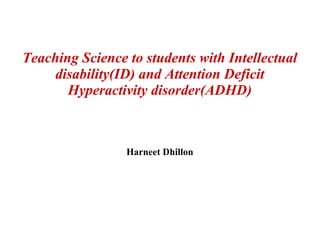
Harneet Presentation2
- 1. Teaching Science to students with Intellectual disability(ID) and Attention Deficit Hyperactivity disorder(ADHD) Harneet Dhillon
- 2. Presentation Overview Intellectual disability Attention deficit hyperactivity disorder Accommodations in Teaching Science
- 3. Intellectual Disability Definition of ID Intellectual disability is a disability characterized by significant limitations in both intellectual functioning and in adaptive behavior, which covers many everyday social and practical skills. This disability originates before the age of 18. (American association of developmental and intellectual disabilities) Demographics: 7.3 % of the students aged 6-21 identified with disabilities were in intellectual disability. Approximately 348,000 students were labeled with mild intellectual disability.
- 4. Criteria to identify ID Low IQ Deficits in adaptive behavior Long Term problem Affects Educational performance • 70 or below • Failure to meet personal or sociocultural standards for personal independence or social responsibility • Limited functionality in activities such as communication, independent living and social participation • Not due to short term factors such as head injury or trauma. • Onset usually during the developmental period Educational performance affected in all academic areas
- 5. Levels of Intellectual disability: Label Range of IQ Scores Mild intellectual ability 50/55 to approximately 70 Moderate intellectual disability 35/40 to 50/55 Severe intellectual disability 20/25 to 35/40 Profound intellectual disability Below 20/25 Reference: Rosenberg, Westling, McLeskey,Special Education for today's teachers: An introduction
- 6. Attention deficit Hyperactivity disorder(ADHD) Definition of ADHD: Brain based disorder that results in significant inattention,hyperactivity, distractibilty or a combination of these characteristic Demographics: About 6.4 million children have received an ADHD diagnosis at some point ADHD diagnoses have increases 16 % since 2007 and 53% in the past decade. Boys (13.2%) were more likely than girls (5.6 %) to have ever been diagnosed with ADHD Less than 1% are identified under IDEA as other health impaired. Source : Center for disease control
- 7. Characteristics/Criteria of ADHD Impulsivity Hyperactivity Inattention Coexisting conduct problem Coexisting academic problems (Special Education for today's teachers: An Introduction, Rosenberg, Westling , McLeskey)
- 8. Data on performance of students with and without disabilities Why consider?? Data allows comparison of performance between students with and without disabilities. Performance levels indicate levels of what students know and what they should have been able to do at grade level measured. Show the quantitative aspect of gaps that persist between students without and without disabilities
- 9. Data from National Assessment of Educational progress for grade 8 Science
- 10. Teaching of Science Planning for engagement with important science ideas Eliciting students ideas Supporting on going changes in thinking Evidence Based explanations 2 3 4 1
- 11. Accommodations for ID Content Use of graphic or advanced organizer to recall prior knowledge . Audio recordings or video recordings to present a lesson. Powerpoint presentations with regular pauses to discuss observations and assimilate newly acquired information. Written procedures or steps for laboratory work. Large print material instead of regular print.
- 12. Process accommodations Written instructions will be provided by teacher. ID students will work with teachers during hands-on activity tasks.
- 13. Evaluation Students evaluation will be done through oral responses dictated to scribe. Extra time will be provided to complete the required evaluation.
- 15. Physical Accommodations: Student with ADHD will be seated near teacher, away from distractions. Lab space would be organized with tapes marking boundaries. Putting day schedule of activities on wall to make the things more predictable and easier transition from one activity to another.
- 16. Instructional accommodations: Instruction would be offered in small steps or 'trial' units. Animations and videos would be shown on computer Important/key concepts would be placed on wall Written instructions/steps to complete activity Instead of written responses, oral responses would be recorded on speech to text software. Visual cues and signals would be used to direct towards finishing desired activities.
- 17. Behavioral accommodations Video recording and display equipment to provide a visual model of targeted behavior or skill will be utilized. Positive verbal and written feedback. Weekly Communication with parents.
- 18. Conclusion It is necessary for success of learning disable that: Their nature be better understood. Needs be better defined. Appropriate accommodations be sufficiently made in teaching learning process.